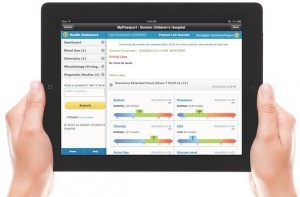 While Boston Children’s Hospital’s Chief Innovation Officer Naomi Fried has called for others to build more hospital apps in the past, her team is also working to bring new ones into operation at Boston Children's through an innovation program. She outlined about half a dozen of such projects during a talk at a mobile health event in Boston this week.
While Boston Children’s Hospital’s Chief Innovation Officer Naomi Fried has called for others to build more hospital apps in the past, her team is also working to bring new ones into operation at Boston Children's through an innovation program. She outlined about half a dozen of such projects during a talk at a mobile health event in Boston this week.
Fried stressed that there is an overabundance of personal health and fitness apps in the market -- around 80 percent of health apps are for consumers by her count. The rest are developed for a hospital environment, but most of those are just mobile versions of an existing medical website or tool.
"Relatively speaking," Fried said. "There are very few truly innovative mobile apps being created."
Fried is quick to acknowledge that there are many barriers to creating hospital apps, including the complexity of integrating them with clinical systems and issues around privacy and security. Given how tied up most hospital IT teams are with meaningful use, ICD-10 and more, hospital apps often have to take a back seat, she said.
Still, Fried and her team have found a way to push innovative ideas through at Boston Children's.
The Fast Track Innovation in Technology award (FIT), which first began in 2010, offers employees at Boston Children's the opportunity to submit an idea for how to make the hospital experience better and more efficient. These ideas are then brought to the pilot stage by Fried's innovation team and could become a part of the hospital's workflow if successful.
Fried spoke about seven ideas -- not all of them were mobile apps -- that have been piloted at the hospital.
The first and only one that has gone beyond the pilot stage, ALICE, which stands for Aggregated Local Information Collected Electronically, is a smart whiteboard that can print a copy of the caregiver assignment sheet, perform a historical lookup of patient caregiver assignments and pull information from the board to help doctors find their patients.
The second project she spoke about, GPU Occupancy Tracker, is a digital solution to move patients through the gastroenterology procedure unit with the use of a barcode system. After the pilot, Fried and her team saw that patients were moving through the system 12 percent faster.
To combat the rate of unnecessary readmissions, Dr. Vincent Chiang created a text message system to send messages to patients who've been discharged, with a series of questions about their care at the facility. Once the patient responds, Boston Children's knows which patients they might need to follow up with. This can help reduce the rate of unnecessary readmissions.
Another FIT concept is BEAPPER, a bidirectional electronic alert patient-centered provider encounter record that serves as a communication tool in the emergency room. In a large emergency department, hospital care providers need a way to communicate better, Fried said. The app, which was created by Dr. Debra Weiner, allows a care team to send quick messages to each other. The Twitter-like application helps care givers to communicate with each other better and more efficiently, according to a video that Fried shared during her presentation.
The BEAPPER software lets care providers know when orders have been placed, beds are vacant, and more. If the program saves providers five minutes per patient, Boston Children's can see 1,400 additional patients a year, according to Weiner.
Another hospital app Fried briefly discussed was Dr. Timmy Ho's Resident Tasklist, which helps organize the way doctors interact with residents on rounds.
Fried also described two patient-facing apps. MyWay is a way-finding app that tackles the 150 floors and 15,000 rooms of Boston Children's Hospital. Thus far, the app has had more than 7,000 downloads.
The other patient-facing app, MyPassport is meant to help people who might not speak English as their native language or speak English well, but don't understand the hospital process and want to track what's happening when their child is admitted to the hospital. In four steps the patient and his or her family can access lab results in a graphical user interface to explain what the labs mean; headshots of everyone on the clinical team that is caring for the patient; a care plan where nurses outline the steps and milestones patients must take before they can be discharged; and a communication tool where patients can send messages to their care team.
Thus far Fried and her team have built seven solutions in two years and aim to build one every three to six months. As the group has built more apps, they have noticed there are reusable features so they hope to start moving faster as they get more experienced.
Fried's main goal is to ensure that every new solution is answering a current problem that Boston Children's Hospital is facing and making sure all the current technologies used are meeting the needs of care givers and patients, which are also her key considerations when bringing in outside vendors.
She said that she is also looking for partners that can take what her team has built and commercialize it and bring it to other care systems.












